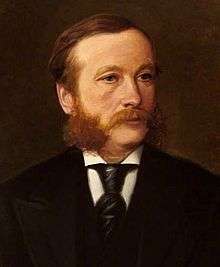Sir William Hart Dyke, 7th Baronet
| The Right Honourable Sir William Hart Dyke Bt DL JP | |
|---|---|
 | |
| Chief Secretary for Ireland | |
|
In office 25 June 1885 – 23 January 1886 | |
| Monarch | Victoria |
| Prime Minister | The Marquess of Salisbury |
| Preceded by | Henry Campbell-Bannerman |
| Succeeded by | William Henry Smith |
| Personal details | |
| Born | 7 August 1837 |
| Died | 3 July 1931 (aged 93) |
| Nationality | British |
| Political party | Conservative |
| Spouse(s) |
Lady Emily Montague (d. 1931) |
| Alma mater | Christ Church, Oxford |
Sir William Hart Dyke, 7th Baronet PC, DL, JP (7 August 1837 – 3 July 1931) was an English Conservative politician and tennis pioneer.
Background and education
The second son of Sir Percival Hart Dyke, 6th Baronet and Elizabeth Wells, Hart Dyke was educated at Harrow School and Christ Church, Oxford. He was described as "one of the best amateur rackets players of his day". In 1860, won the championship from a professional player (Francis Erwood) at the Prince's Club, which was the former headquarters of rackets. In 1873 he played lawn tennis in a significant early match with John Moyer Heathcote and Julian Marshall at Lullingstone Castle. In 1875 with Heathcote he was a member of the Marylebone Cricket Club committee that framed the original set of rules for tennis.Lullingstone Castle
Political career

Hart Dyke was Conservative Member of Parliament for West Kent between 1865 and 1868, for Mid Kent between 1868 and 1885 and for Dartford between 1885 and 1906. He was a Conservative whip from 1868 to 1874, and held ministerial office under Benjamin Disraeli as Parliamentary Secretary to the Treasury from 1874–1880 and under Lord Salisbury as Chief Secretary for Ireland from 1885 to 1886 and as Vice-President of the Committee of the Council on Education from 1887 to 1892. He succeeded father to the baronetcy in 1875, and was appointed a Privy Counsellor in 1880.
Family
Hart Dyke married Lady Emily Caroline Montague, daughter of the 7th Earl of Sandwich, in 1870.He died in July 1931, aged 93, and was succeeded in the baronetcy by his fourth and only surviving son, Oliver. Lady Hart Dyke only survived her husband by a month and died in August 1931.[1]
References
External links
- Hansard 1803–2005: contributions in Parliament by Sir William Hart Dyke
| Parliament of the United Kingdom | ||
|---|---|---|
| Preceded by Viscount Holmesdale Sir Edmund Filmer, Bt |
Member of Parliament for West Kent 1865 – 1868 With: Viscount Holmesdale |
Succeeded by Sir Charles Mills John Gilbert Talbot |
| New constituency | Member of Parliament for Mid Kent 1868 – 1885 With: Viscount Holmesdale 1868–1880 Sir Edmund Filmer, Bt 1880–1884 John Stewart Gathorne-Hardy 1884–1885 |
Constituency abolished |
| New constituency | Member of Parliament for Dartford 1885 – 1906 |
Succeeded by James Rowlands |
| Political offices | ||
| Preceded by Arthur Wellesley Peel |
Parliamentary Secretary to the Treasury 1874–1880 |
Succeeded by Lord Richard Grosvenor |
| Preceded by Henry Campbell-Bannerman |
Chief Secretary for Ireland 1885–1886 |
Succeeded by William Henry Smith |
| Preceded by Henry Holland |
Vice-President of the Committee of the Council on Education 1887–1892 |
Succeeded by Arthur Herbert Dyke Acland |
| Baronetage of England | ||
| Preceded by Percival Hart Dyke |
Baronet (of Horeham) 1875–1931 |
Succeeded by Oliver Hart Dyke |